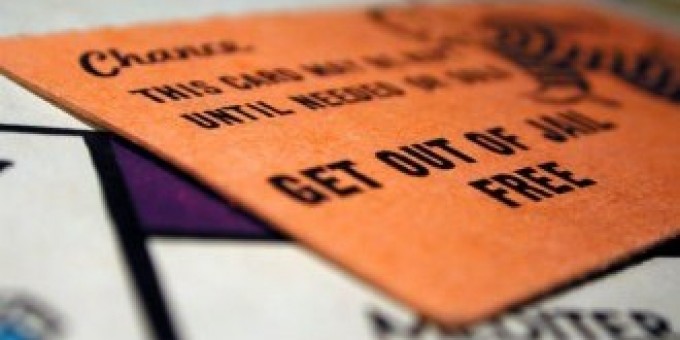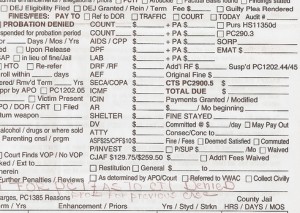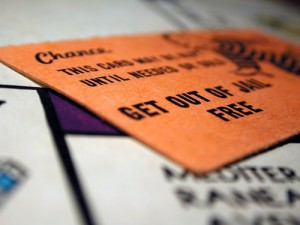
“Do the crime, pay the fine.” A little different, right? Many are unaware that when convicted of breaking the law, not only do people “pay” for their crimes by doing time, but they are also forced to pay up financially. The costs include court processing, defense attorneys, paper work, and anything else associated with their incarceration and supervision. In fact, anyone convicted of any type of criminal offense is subject to fiscal penalties or monetary sanctions. (If you have ever paid a traffic ticket, for example, you have paid a monetary sanction.) Further, the base fine of, say, a speeding ticket or even a major criminal conviction is just a small portion of the total cost. There are fines, fees, interest, surcharges, per payment and collection charges, and restitution. Until these debts are paid in full, individuals who have otherwise “done their time” remain under judicial supervision and are subject to court summons, warrants, and even jail stays.
As a result of interest and surcharges that accumulate on these financial penalties, this portion of a person’s sentence becomes permanent legal debt, carried for the remainder of their lives. And because so many who are arrested and convicted are poor, unemployed, homeless, or suffer from mental or physical illnesses, the fines just pile up—unable to be erased through bankruptcy—and tie them, indefinitely, to the criminal justice system. For them, debt is a life sentence.How Monetary Sanctions Work
My research investigates the growth, process, and impact of legal financial obligations. Fines have always been imposed in the American criminal justice system. However, starting in the early 1990s, states began changing laws to dramatically expand the number and types of fees and surcharges they can impose. Each state legislature has constructed particular statutes to detail the types of monetary sanctions that judges can impose in addition to incarceration for felony convictions. Individual counties then implement their own formal (legally prescribed by county code) and informal (decided by local clerk offices) policies that guide amounts imposed at sentencing hearings, as well as the procedures for monitoring and collecting these fees.
A recent study of fifteen states by the Brennan Center for Justice (at New York University) found that every state studied imposed fines upon conviction; imposed parole, probation, or other supervision fees; and had laws authorizing the imposition of incarceration fees. In Louisiana, indigent defendants are assessed an up-front fee of $40 for their public defender (mind you—the whole point of a public defender is to provide legal counsel for those who cannot afford it), and, at the time of sentencing, they are assessed an additional $300 fee for the “Judicial Expense Fund.” North Carolina has a “cost of justice fee” of $154.50 imposed on all felony defendants (the fine isn’t contingent upon conviction).

In Washington State, monetary sanctions are called Legal Financial Obligations (LFOs). These sanctions are imposed by judges at sentencing hearings, but are monitored by court clerks (non-elected bureaucrats). The mandatory minimum LFO is a $500 victim penalty assessment, a $100 DNA collection fee, and a $200 clerk surcharge. As a result of additional fines and fees added, the average monetary felony sentence (not including restitution for victims) in 2004 totaled just under $1,400—an enormous sum for many desperately poor clients in the criminal justice system. These costs are imposed per felony conviction; so, if someone is convicted of multiple counts or offenses, the fines are multiplied. The initial amount also accumulates dramatically: 12% interest begins accruing from the day of sentencing, and a $100 annual collection surcharge is added to unpaid balances per felony conviction. Thus, for example, an LFO of $1,347 making monthly payments of $100 would pay off their fine in 16 months. Assume, however, that the defendant cannot make a payment. By the end of the sixth month, the LFO is now a bit over $1,400. After a year the total debt is over $1,600—for each charge.
The Costs of Sanctions
Remember, legally speaking, monetary sanctions are equivalent to court sentences such as jail or prison, community service, or probation. Until the legal debt is paid in full (including interest and surcharges), the defendant will remain under court jurisdiction, subject to violations for missed payments. Those with unpaid court debts cannot receive certificates of discharge, seal their records, receive pardons, or request deferred prosecution—legal mechanisms meant to allow those who have completed their sentences to move past their felony conviction to become productive citizens. These tools are essential for applying for a job, renting or purchasing a home, and applying for credit, since employers, landlords, and lenders frequently search applicants’ credit and legal backgrounds. Legal debt effectively derails prospects for success after conviction.
There are other consequences for poor felony defendants who enter “deferred sentence agreements,” which are intended to remove convictions from legal records if all fines, fees, and other court-imposed obligations are met (for example, attending drug treatment or performing community service). Poor defendants who meet the court requirements but cannot pay their fines and fees will continue to carry a felony record. Those defendants who can afford to pay the monetary sanctions, however, can quickly close the door on their criminal justice experience with a deferred sentence agreement.In short, poverty, rather than public safety, determines who remains subject to criminal justice surveillance and sanctioning and to the stigmatizing effects of felony conviction. Legal debt is typically substantial relative to the expected earnings of people with felony convictions, and it is usually long-term. In several U.S. jurisdictions, felons are regularly summoned to court and incarcerated for making insufficient or irregular payments toward their monetary sanctions. Debt can put a person back behind bars.
21st Century Debtors’ Prisons

My forthcoming book A Pound of Flesh contrasts the growth of monetary sanctions with the legal protections against incarcerating the poor. The United States did away with debtors’ prisons in the 1830s, yet we’ve been expanding contemporary practices of imprisoning those who cannot pay court-related fiscal penalties. Ironically, in an era where state legislatures have decreased judicial discretion in sentencing to limit disparities, we see unfettered discretion in the imposition of fiscal penalties.
Courts can legally impose jail days when those they convict are assessed as “willfully” not paying (that is, hiding money, not seeking employment to avoid making payments, or not seeking reasonable support from friends or family). Willful nonpayment constitutes contempt of court, so felons are seen as being sanctioned for contempt, not for their inability to pay. In researching my book, I repeatedly observed judges use their discretion to make assessments of non-paying legal debtors, deciding they had not been putting forth “enough effort” to raise money. One unemployed homeless man in Washington State was told he should have been begging for money by the side of the road to raise money toward his debt.
Homeless, unemployed, or disabled persons like the man I describe are, in many jurisdictions, ordered to serve 10-60 days for contempt of court. Homeless debtors who have no address at which to receive notices of delinquency for non-payment are frequently arrested for their failure to appear in court. They can spend several nights in jail awaiting hearings. This process of extreme punishments for nonpayment only worsens the class disparities in criminal justice experiences and outcomes.
Worsening Inequality
Legal debt is important. It affects many people—disproportionately poor people and people of color—and it has pernicious, tenacious consequences. And the U.S. criminal justice system affects more and more people: 1 in 37 U.S. adults has spent time in state or federal prisons; more than 700,000 people leave prison each year; and there are an estimated 16.1 million current and former felons in the United States. The debt is accumulating at an unimaginable rate.
Ironically, as a result of mass conviction and incarceration, jurisdictions cannot afford criminal justice costs. They are attempting to literally transfer these expenses to defendants. Since the vast majority of people who receive felony convictions in the U.S. have minimal employment and income prospects post-conviction, monetary sanctions deepen existing inequalities. Poor people carry the onerous weight of a criminal record in very different ways and for longer periods of time than those with financial resources and good connections (that is, people from whom they can borrow money). In effect, because they can’t pay their debts, the poor become perpetual subjects of the criminal justice system.Why We Should Care
Law-abiding citizens (or those lucky enough to have never been caught and convicted) should care about this criminal justice practice: it is done in our names. The imposition of legal debt leads people convicted of crimes into further political, social, and economic marginalization. It is unproductive. Monetary sanctions attached to felony convictions are not efficient, effective, or ethical.
This is not an efficient process. Because of the lack of automated court data, we do not know the extent of total debt owed, nor is there much information about the total dollars recouped by state and local jurisdictions. There is no consistency in how courts or jails “code” or keep track of defendants incarcerated purely for non-payment. Thus, we cannot know how many are jailed or how much is spent on monitoring, arresting, and incarcerating people for non-payment. Researchers truly cannot calculate the total criminal justice resources consumed in managing legal debtors, collecting outstanding debt, and sanctioning those who have not made payments.
This is not an effective process. In many ways, monetary sanctions impose a barrier to rehabilitation or accountability. Legal debtors I have interviewed were frustrated, angry, and distrustful of a system that imposed financial debt in addition to imprisonment, community stigma, and other consequences. When people cannot pay or when the debt causes financial hardship, the sentence becomes self-defeating; many will try to avoid the criminal justice system altogether (they will ignore court summons or avoid police when they know they have warrants). Thus, they are not “held accountable” for their offenses, and they become isolated, frustrated, depressed, and disillusioned. Many defendants will never be able to pay off their legal debt (even when making regular payments), and, hence, their “debt to society” stands. Legal debt also impacts successful community reintegration: it stymies housing, employment, stable familial relationships, and the ability to view oneself as a productive adult citizen.
This is not an ethical process. Imposing fiscal debt on already marginalized people who will face further marginalization after release from jail or prison is unjust. They have already been sentenced to a host of penalties: incarceration, community supervision, community service, drug and alcohol treatment, and victim panel classes. Adding monetary sanctions sets people up for failure; we know the vast majority will never be able to pay off the debt. Further, this system provides a clear example of how the criminal justice system treats the wealthy and the poor differently. People with money can pay their fines and fees the day they are sentenced, with no future non-payment penalties. They can seal their cases faster. They can avoid repeated trips to the courthouse to make payments, sit before various judges, or provide monthly updates on their employment and housing circumstances. Because of monetary sanctions, the criminal justice experience is dramatically different for poor defendants. The practice sentences poor people to lives of poverty and punishment, releasing the wealthy to freedom.What Needs to Be Done
Discussions about justice and punishment. Local, state, and national jurisdictions must revisit the place of monetary sanctions in contemporary justice. Such discussions could be used as a framework to discuss the reliance on and appropriate role of monetary sanctions in justice processing. Should we try to reform practices to impose more reasonable sentences (either fiscal or physical) that defendants can realistically fulfill? Is it ethical and prudent to impose sentences we know people will never be able to complete? What are the aims, purposes, and end goals of punishment?
Abolition of non-restitution monetary sanctions. My research leads me to conclude that the most sensible policy is to abolish all non-restitution monetary sanctions for criminal offenses. The vast discretion given to judges and court clerks to impose and monitor legal debt and the ways this discretion has been used to further punish poor debtors troubles social justice advocates for very good reason: we cannot assess the total amounts of outstanding debt at local, state, and national levels, so we cannot challenge the notion that monetary sanctions make financial sense. Yet we know three things: imposing legal debt is counterproductive to the rehabilitative process; it provides a clear example of differential treatment of the wealthy and poor; and it leads to long-term criminal justice surveillance and sanction.
Recommended Reading
American Civil Liberties Union. 2010. “In For a Penny: The Rise of America’s New Debtors’ Prisons.” New York. Examines the implementation of monetary sanctions in five U.S. states to make the case that, despite having outlawed them, the country does have a contemporary system of debtor’s prisons.
Alicia Bannon, Mitali Nagrecha, and Rebekah Diller. 2010. “Criminal Justice Debt: A Barrier to Reentry,” Brennan Center for Justice. Finds that monetary sanctions are increasing across state courts and details how they create a barrier to community reentry post-conviction and rehabilitation.
Alexes Harris. Forthcoming. A Pound of Flesh: Monetary Sanctions as a Permanent Punishment for Poor People. Russell Sage Foundation ASA Rose Series in Sociology: New York. Using Washington State as an example, this book examines the growth of monetary sanctions and their impacts on the country’s most impoverished citizens.
Alexes Harris, Heather Evans, and Katherine Beckett. 2010. “Drawing Blood from Stones: Monetary Sanctions, Punishment and Inequality in the Contemporary United States,” American Journal of Sociology 115(6): 1753–1799. Uses interview data to examine the social and legal consequences of legal fines and fees.

Comments 10
Sarah Lageson — March 4, 2014
This is excellent coverage of an issue that doesn't get the attention it needs. Thank you for writing it!
Josh Page — March 4, 2014
I agree with Sarah. Thank you.
Alexes Harris on Monetary Sanctions — and More Crime on TSP » Public Criminology — March 5, 2014
[…] 1. The Cruel Poverty of Monetary Sanctions by Alexes Harris — a terrific piece on prisoners and debt […]
Debt is a Life Sentence | Root & Rebound — March 6, 2014
[…] when I got home last night, I found that a friend had post this article to Facebook– The Cruel Poverty of Monetary Sanctions, by Alexes Harris, part of sociology department at the University of Washington. This article […]
Friday Roundup: March 7, 2014 » The Editors' Desk — March 7, 2014
[…] “The Cruel Poverty of Monetary Sanctions,” by Alexes Harris. When legal debt becomes a life sentence, long past time served. […]
Letta Page — May 21, 2014
Pairs wonderfully with the new NPR series "Guilty and Charged"! http://www.npr.org/series/313986316/guilty-and-charged
Jay — October 5, 2014
Sounds about right..When I was released from minnesota department of corrections I was homeless and jobless.I am still on supervised release for Felony Terroristic Threats for two more years .I report monthly and provide a drug test.I also owe somthing like 6,750 dollars and have not once made a payment.How can I pay Im living on the streets and getting employment has been next to impossible.As far as im concerned they (MDOC) (Minnesota Department of Corrections) will not see a penny from me .Its wrong to force human beings to live on the streets , while the court house employees , judges ..ect...all are well off financilly .Most times this is the reason for committing crime .Despert , homeless, cold, dirty, and hungery.Before I was arrested, charged and sentenced I was working full time in a restraunt, attending college , living in a decent apartment and just being another responsible adult doing my part in society.Now I have become the complete opposite.I was only locked up for 18 months but that year and ahalf im afraid screwed my future I cannot get my job back , lost my apartment and school rejected my application with a letter of how much I owe them ...So the moral of the story is dont get all drunk and talk sh@t. Because it will defintley F*ck up your future...
Joanne D — June 17, 2016
Thank you, Dr. Harris. I see that the book is now available - Congratulations! I will share the Take Part interview as well as this article, for which I thank you.
Joanne D — June 17, 2016
Sorry - saw too late I mistyped my email - this one is correct.
Everyday Erinyes – Politics Plus — June 18, 2016
[…] so I'll be leaning heavily on the interview in Take Part which led me to the subject, and on a white paper the author, Dr. Alexes Harris, a Professor of Sociology at the University of Washington, posted […]